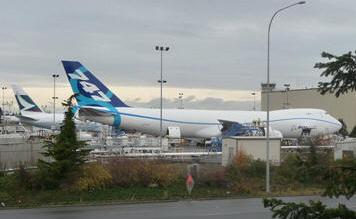|
|||||||||||
|
|
|
|||
|
By Bill Goldston |
||||
 |
October 2, 2010 -
Boeing announced a schedule change for the 747-8 Freighter with first
delivery now expected mid-year 2011. The company also announced steps it
is taking to support the new schedule, including adding a fifth airplane
to the flight-test fleet. The company previously indicated that, following recent flight-test discoveries, there was a high probability the first 747-8 Freighter delivery would move into 2011.
The new delivery
schedule follows a thorough assessment of the expected cumulative impact
of these discoveries, which include a low-frequency vibration in certain
flight conditions and an underperforming aileron actuator.
|
|||
|
|
||||
|
While neither
issue requires structural changes to the airplane, they have led to
disruptions to certification testing, which the program was unable to
offset within the prior schedule. This schedule change is not expected
to have a material impact on Boeing's 2010 financial results.
"We understand the
issues encountered in flight test and are working through the
solutions," said Pat Shanahan, vice president and general manager,
Airplane Programs, Boeing Commercial Airplanes. "We recognize our
customers are eager to add the 747-8 Freighter to their fleets, and we
understand and regret any impact this schedule change may have on their
plans to begin service with the airplane. With that said, the 747-8
Freighter is demonstrating the capabilities our customers need to be
successful and we are confident in the value it will bring them upon
certification and delivery next year."
The 747 has proven
to be a very popular freighter, carrying around half of the world's air
freight as of 2007. In an effort to maintain this dominant position,
Boeing designed a freight variant of the 747-8, named the 747-8
Freighter or 747-8F, which was launched on November 14, 2005.
The 747-8F will be the initial model to see entry into service (EIS). As on the 747-400F, the upper deck is shorter than passenger models; the 18 feet 3? inches (5.575 m) stretch is just before and just aft of the wing. With a 975,000 lb (442,000 kg) maximum take-off weight, it will have a total payload capability of 308,000 lb (140,000 kg) and a range of 4,390 nmi (8,130 km). |
||||
|
Four extra pallet
spaces will be created on the main deck, with either two extra
containers and two extra pallets, or three extra pallets, on the lower
deck. The 747-8F is expected to achieve a 16% lower ton-mile operating
cost than the 747-400F and offer a slightly greater range.
The 747-8F will
have more payload capacity but less range than the current 747-400ERF.
When Boeing launched the 400ERF, all of the 35,000 lb (16,000 kg)
increase in MTOW over the 747-400F 875,000?910,000 lb (397,000?410,000
kg) allowed airlines to take off with more fuel, burn it during flight,
and land at the same weight as the regular 747-400F.
This increased the
range of the 747-400ERF compared to the 747-400F. Cargo carriers often
move machinery or indivisible loads that require a plane with a higher
payload and landing capability. As is common with cargo planes, range is
given with maximum payload, not fuel. The 747-8's 65,000 lb (29,000 kg)
MTOW increase has been directed exclusively to its Zero-Fuel weight or
payload capacity. If taking off at maximum payload, the 747-8 takes off
with its tanks not full. On trips where the payload is not at maximum,
the plane can take on more fuel and extend its range.
Cargolux and
Nippon Cargo Airlines were the first customers for the 747-8, placing
orders for the freighter variant in November 2005. The first scheduled
delivery of the 747-8 will be to Cargolux in the fourth quarter of 2010.
The firm configuration of the aircraft was finalized in October of 2006.
Major assembly of the aircraft began on August 8, 2008, and the aircraft
first left Boeing's |
|
|
| Other News Stories |
| ?AvStop
Online Magazine
Contact
Us
Return To News
|
|


